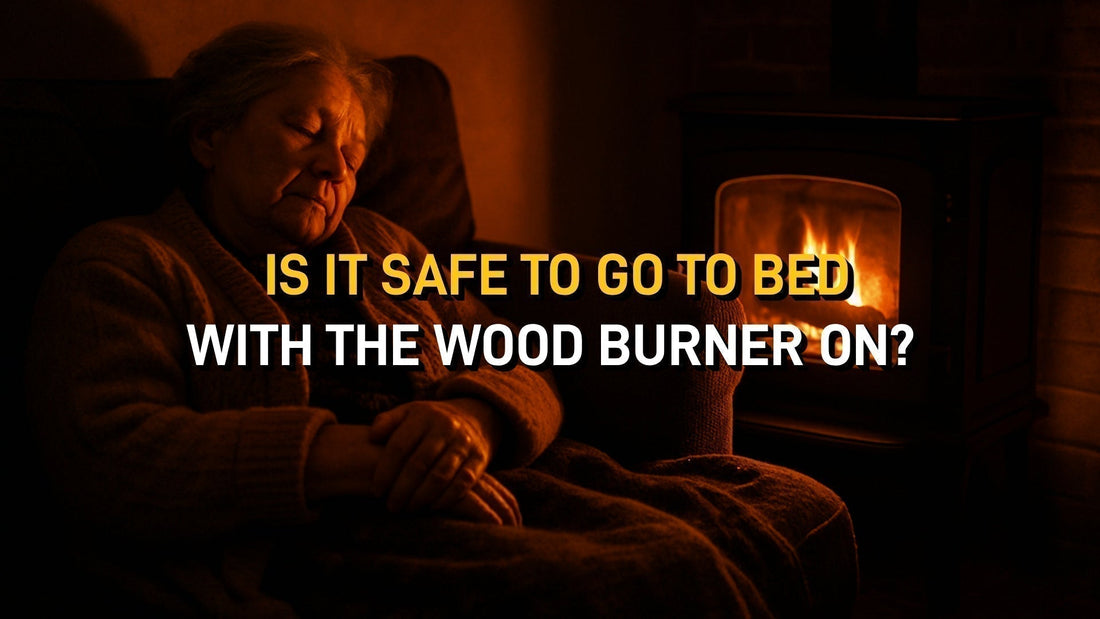
Can You Leave a Wood-Burning Stove On and Go to Bed? The Complete Safety Guide
Ever found yourself wondering “Can I leave my wood burning stove on overnight?” or “Is it safe to go to bed while the fire is still going?” Well, you're definitely not alone. These are some of the most frequently asked questions our customer support staff receives here at Lekto. Especially in the colder months of the year.
The answer from our wood fuel experts? Yes, but it's complicated.
In this expert-written guide, we’ll walk you through everything you need to know about leaving a log burner on unattended. From controlling airflow and choosing the right fuel, to what not to do before bed.
You Might Also Like:
Best Firewood Logs to Burn Chart UK
New UK Log Burner Rules & Fines

Nothing has the same wow factor as a beautifully burning fire.
Is It Safe to Leave a Wood-Burning Stove Unattended?
Yes, you can leave your wood burning stove to burn out overnight, for example, when heating with 8-hour Night Briquettes, but only if you follow the right safety steps.
What are the ingredients for a safely burning unattended burner? A bit of preparation and forethought. The right wood fuel for the job. And some common sense.
A modern, EcoDesign or clearSkies certified wood burner is designed to be safe, efficient, and low-maintenance. But as is the case with anything involving fire, it needs to be treated with care. The key to safety lies in:
- Controlling the burn.
- Removing risks around the stove.
- Ensure your installation is in good condition.
If your stove is properly maintained, your chimney is swept, and you follow the correct steps before leaving the room or going to sleep, the risk of anything going wrong is very low. In fact, many stove owners routinely let their fires die down overnight without issue.
Adjust the Air Vents Before Bedtime
One of the most important factors in stove safety, and in how the fire behaves overnight, is airflow control.
Should wood burner vents be open or closed at night?
When you’re ready to leave your wood burner unattended, don’t close the air vents completely. Instead, turn them down to their lowest safe setting. This reduces the oxygen supply to the fire, causing it to burn more slowly and evenly as it dies down.
Closing the vents entirely is a mistake. It can lead to poor combustion, excessive smoke, and even soot build-up inside the stove or flue. On the other hand, leaving them too far open could cause the fire to burn too hot and fast.
Pro tip: Once the flames have subsided and the logs have broken down into glowing embers, that’s the perfect time to reduce the air intake. The fire will then slowly extinguish itself overnight.

Wood fuel selection of a Morrisons petrol station.
Choose the Right Fuel for Overnight Burning
Not all wood fuel is created equal. If you want your stove to stay warm safely through the night (without having to get up to refuel) the type of fuel you use makes a big difference.
What fuels that are unsuited for overnight burns? Softwood logs and quick-burning briquettes. They will produce a lot of heat quickly, but then your rooms will grow cold again, negating the reason for leaving the stove on overnight anyway.

8-hour Night Briquettes are tailor-made for long-lasting, zero-fuss heat.
8-Hour Night Briquettes
Lekto’s Night Briquettes are Britain's flagship long-burning briquette product. They're designed specifically for long, slow burns, including (but not limited to) at night. Made from 100% natural softwood bark, this natural briquette can burn up to 8 hours. They’re also incredibly efficient, meaning you can save money by lowering your overall wood fuel consumption.
Learn more about Lekto Night Briquettes

Universal Fire Logs
Want a stronger push of heat to help you fall asleep? Then universal Fire Logs could be a good fit. They can burn for 2-3 hours, providing heavy heat throughout this time. This is more than enough time for you to fall asleep. Their rectangular no-roll shape also makes them safer for use unattended.
Learn more about Lekto Fire Logs
Natural Firelighters
If the main reason you want to keep your stove overnight is that you don't want to deal with the hassle of having to relight it in the morning, then you may forgo the risks that come with burning logs at night altogether.
Having a box of Natural Firelighters on hand makes restarting the stove in the morning effortless. Starting a fire with them and some kindling takes under a minute using the Top Down Method. And once you light your firelighters, you can be free to go about your day. The fire will definitely catch.
Learn more about Lekto Natural Firelighters
Clear the Area Around the Stove
A little foresight always pays dividends. Before you head to bed, do a quick safety check of the area around your wood burner. Even with the door closed and the fire under control, it is always smart to remove anything that could ignite from residual heat (even if you think that ignition is highly unlikely). Here are some examples of things that have no business being next to your stove:
- Paper, cardboard, or kindling. This is very dangerous as these can easily ignite from residual heat. And once that happens, they will transfer the fire to the entire pile.
- Candles, matches, or firelighters. This should be 100% clear to everyone. These easily combustible items have no business being anywhere near your stove.
- Spare logs or briquettes. While less dangerous than paper or cardboard, logs and briquettes can still be a fire hazard. While they might not easily ignite from residual heat, your stove glass may still shatter and an ember may fall on them.
- Fabric items like rugs, blankets, or pet bedding. These are far more easily combustible than you think. Countless fires start because of them every heating season.
Pro tip: While distance is often a good enough solution on its own, you won't ever regret installing a simple, inexpensive fire guard. Not only will it make keeping the right distance effortless and safeguard your home from burning embers, it can also provide an extra layer of safety to your pets and children by preventing them from reaching the hot stove.
Have Your Chimney Swept Annually
This is a crucial safety tip that many people ignore. Every time you burn wood, especially wet wood, soot and creosote deposits build up inside your flue. If left unchecked, these deposits can eventually ignite and cause a chimney fire. Regular sweeping not only reduces the risk of chimney fires but also improves your stove’s efficiency and ensures cleaner combustion.
How Often to Sweep Your Chimney?
According to our experts, you need to sweep your chimney at least once a year if you burn high-quality firewood and briquettes. If you use wet wood, then you need to sweep your chimney at least twice a year.
Read more about this in our Ultimate Guide to Chimney Sweeping.
How to Put Out a Wood Burning Stove Safely
If you decide you don’t want the stove to keep burning overnight, here’s the safest way to put it out:
- Let the fire burn down naturally. Avoid adding new fuel in the last couple of hours before bed.
- Spread out the embers. Once most of the wood has burned, gently spread the embers with a poker to help them cool faster.
- Lower the air controls. Reducing oxygen will help the embers die down more quickly.
- Never leave ashes unattended. Once the stove is cool, remove the ash carefully and store it in a metal container.
Can You Leave a Log Burner On and Go Out?
Yes, the same safety principles apply if you’re leaving the house for a short time. As long as the stove door is closed, the airflow is controlled, and the area around the burner is clear, it’s generally safe to leave a wood burner unattended for a few hours. However, if you’ll be away for longer, or if the fire is still roaring, it’s always best to let it burn out completely before you leave.
Key Takeaways
A wood-burning stove is one of the most efficient and enjoyable ways to heat your home. And with a little preparation, there’s no reason you can’t enjoy its warmth overnight or while you’re away from the room.
The key things to remember are:
- Keep your air vents slightly open to control the burn.
- Night Briquettes for slow overnight heat or Hardwood Heat Logs for strong evening warmth.
- Clear the surrounding area of anything flammable.
- Have your chimney swept regularly.
Follow these simple steps and you can go to bed (or even pop out for a few hours) knowing your wood burner is working safely and efficiently.
Want to know more about us? Here's Everything You Need to Know About Lekto.
Read more great articles in the Best of Lekto Blog.
